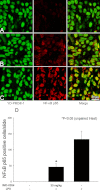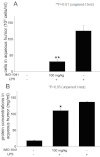Amelioration of endotoxin-induced uveitis treated with an IκB kinase β inhibitor in rats
- PMID: 23112571
- PMCID: PMC3482174
Amelioration of endotoxin-induced uveitis treated with an IκB kinase β inhibitor in rats
Abstract
Purpose: Endotoxin-induced uveitis (EIU) is an animal model for acute ocular inflammation. Several substances play major roles in the development of inflammatory changes in EIU, including tumor necrosis factor-α (TNF-α), interleukin (IL)-1β, and IL-6. These inflammatory cytokines trigger the degradation of IκB by activating IκB kinases (IKKs). Released nuclear factor kappaB (NFκB) subsequently translocates to the nucleus, where NFκB expresses its proinflammatory function. IMD-0354, N-(3,5-Bis-trifluoromethylphenyl)-5-chloro-2-hydroxybenzamide, selectively inhibits IKKβ, particularly when induced by proinflammatory cytokines, such as TNF-α and IL-1β. In the present study, we examined whether IKKβ inhibition has therapeutic effects on EIU by using IMD-0354 and its prodrug IMD-1041.
Methods: Six-week-old male Lewis rats were used. EIU was induced with subcutaneous injections of 200 μg of lipopolysaccharide (LPS) from Escherichia coli that had been diluted in 0.1 ml of phosphate-buffered saline. IMD-0354 was administered intraperitoneally at 30, 10, 3, or 0 mg/kg, suspended in 1.0 ml of 0.5% carboxymethyl cellulose sodium. The prodrug IMD-1041 (100 mg/kg) was also administered orally. The rats were euthanized 24 h after LPS injection, and EIU severity was evaluated histologically. The number of infiltrating cells and the protein, TNF-α, and monocyte chemoattractant protein-1 (MCP-1) concentrations in the aqueous humor were determined. TNF-α and MCP-1 concentrations were quantified with enzyme-linked immunosorbent assay. Eye sections were also stained with anti-NFκB and phosphorylated I-κBα antibodies.
Results: The number of infiltrating cells in aqueous humor was 53.6±9.8×10(5), 72.5±17.0×10(5), 127.25±32.0×10(5), and 132.0±25.0×10(5) cells/ml in rats treated with 30, 10, 3, or 0 mg/kg of IMD-0354, respectively. The total protein concentrations of aqueous humor were 92.6±3.1 mg/ml, 101.5±6.8 mg/ml, 112.6±1.9 mg/ml, and 117.33±1.8 mg/ml in rats treated with 30, 10, 3, and 0 mg/kg of IMD-0354, respectively. Infiltrating cells and protein concentrations were significantly decreased by treatment with IMD-0354 (p<0.01). IMD-0354 treatment significantly reduced the concentration of TNF-α (p<0.05) and MCP-1 (p<0.01) in aqueous humor. The number of NFκB positive nuclei was reduced when treated with IMD-0354. Furthermore, IMD-0354-treated EIU rats showed only background levels of phosphorylated I-κBα; however, it was strongly expressed in the iris-ciliary body cell cytoplasm of the IMD-0354 untreated EIU rats. Oral administration of IMD-1041 also decreased the cell number (p<0.01) and protein concentration (p<0.05) of aqueous humor in EIU.
Conclusions: Acute uveitis was ameliorated by inhibition of IKKβ in rats. IMD-0354 and its prodrug IMD-1041 seem to be promising candidates for treating intraocular inflammation/uveitis.
Figures






Similar articles
-
Amelioration of endotoxin-induced uveitis treated with the sea urchin pigment echinochrome in rats.Mol Vis. 2014 Feb 7;20:171-7. eCollection 2014. Mol Vis. 2014. PMID: 24520186 Free PMC article.
-
Anti-inflammatory effect of angiotensin type 1 receptor antagonist on endotoxin-induced uveitis in rats.Graefes Arch Clin Exp Ophthalmol. 2008 May;246(5):747-57. doi: 10.1007/s00417-007-0730-2. Epub 2007 Dec 18. Graefes Arch Clin Exp Ophthalmol. 2008. PMID: 18087711
-
Topical administration of diminazene aceturate decreases inflammation in endotoxin-induced uveitis.Mol Vis. 2015 Apr 10;21:403-11. eCollection 2015. Mol Vis. 2015. PMID: 25883526 Free PMC article.
-
Cytokines and chemokines in uveitis: is there a correlation with clinical phenotype?Clin Med Res. 2006 Dec;4(4):294-309. doi: 10.3121/cmr.4.4.294. Clin Med Res. 2006. PMID: 17210978 Free PMC article. Review.
-
[Anti-TNF-α in the treatment of non-infectious uveitis].Med Sci (Paris). 2020 Oct;36(10):893-899. doi: 10.1051/medsci/2020160. Epub 2020 Oct 7. Med Sci (Paris). 2020. PMID: 33026332 Review. French.
Cited by
-
NF-κB activation in retinal microglia is involved in the inflammatory and neovascularization signaling in laser-induced choroidal neovascularization in mice.Exp Cell Res. 2021 Jun 1;403(1):112581. doi: 10.1016/j.yexcr.2021.112581. Epub 2021 Mar 31. Exp Cell Res. 2021. PMID: 33811906 Free PMC article.
-
Isoproterenol induced stressful reactions in the brain are characterized by inflammation due to activation of NADPH oxidase and ER stress: attenuated by Apocynin, Rehmannia complex and Triterpene acids.Neurochem Res. 2014 Apr;39(4):719-30. doi: 10.1007/s11064-014-1260-z. Epub 2014 Feb 26. Neurochem Res. 2014. PMID: 24570113
-
Protective effects of the galectin-1 protein on in vivo and in vitro models of ocular inflammation.Mol Vis. 2015 Sep 2;21:1036-50. eCollection 2015. Mol Vis. 2015. PMID: 26392742 Free PMC article.
-
The immunoproteasome subunit LMP10 mediates angiotensin II-induced retinopathy in mice.Redox Biol. 2018 Jun;16:129-138. doi: 10.1016/j.redox.2018.02.022. Epub 2018 Mar 1. Redox Biol. 2018. PMID: 29499566 Free PMC article.
-
Amelioration of endotoxin-induced uveitis treated with the sea urchin pigment echinochrome in rats.Mol Vis. 2014 Feb 7;20:171-7. eCollection 2014. Mol Vis. 2014. PMID: 24520186 Free PMC article.
References
-
- Rosenbaum JT, McDevitt HO, Guss RB, Egbert PR. Endotoxin-induced uveitis in rats as a model for human disease. Nature. 1980;286:611–3. - PubMed
-
- de Vos AF, van Haren MA, Verhagen C, Hoekzema R, Kijlstra A. Kinetics of intraocular tumor necrosis factor and interleukin-6 in endotoxin-induced uveitis in the rat. Invest Ophthalmol Vis Sci. 1994;35:1100–6. - PubMed
-
- Planck SR, Huang XN, Robertson JE, Rosenbaum JT. Cytokine mRNA levels in rat ocular tissues after systemic endotoxin treatment. Invest Ophthalmol Vis Sci. 1994;35:924–30. - PubMed
-
- Jacquemin E, de Kozak Y, Thillaye B, Courtois Y, Goureau O. Expression of inducible nitric oxide synthase in the eye from endotoxin-induced uveitis rats. Invest Ophthalmol Vis Sci. 1996;37:1187–96. - PubMed
-
- Bellot JL, Palmero M, Garcia-Cabanes C, Espi R, Hariton C, Orts A. Additive effect of nitric oxide and prostaglandin-E2 synthesis inhibitors in endotoxin-induced uveitis in the rabbit. Inflamm Res. 1996;45:203–8. - PubMed
Publication types
MeSH terms
Substances
LinkOut - more resources
Full Text Sources
Research Materials
Miscellaneous
